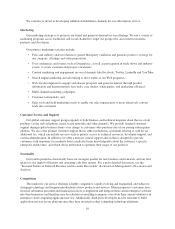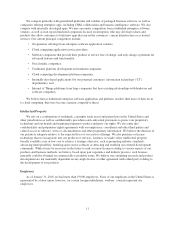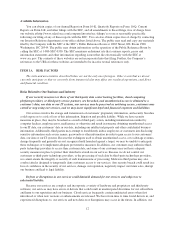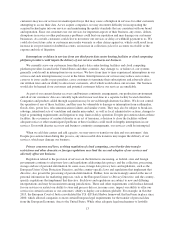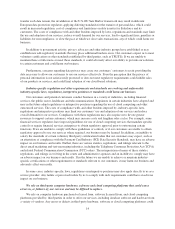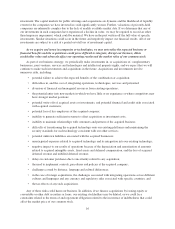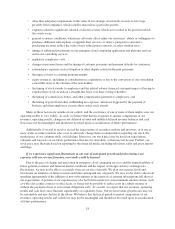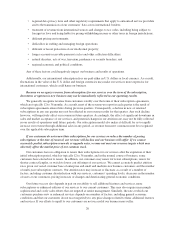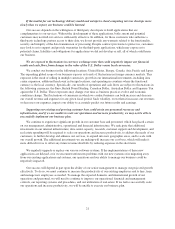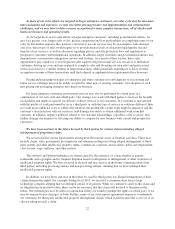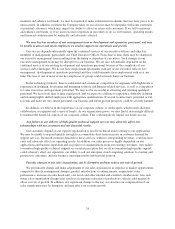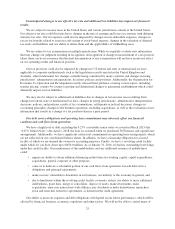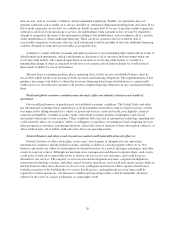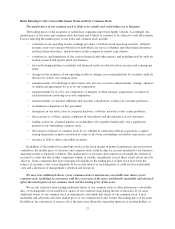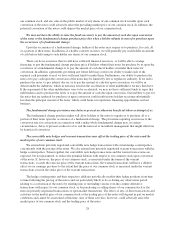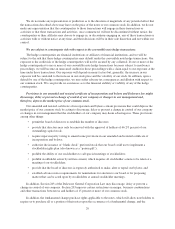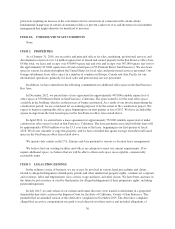Salesforce.com 2016 Annual Report Download - page 27
Download and view the complete annual report
Please find page 27 of the 2016 Salesforce.com annual report below. You can navigate through the pages in the report by either clicking on the pages listed below, or by using the keyword search tool below to find specific information within the annual report.• regional data privacy laws and other regulatory requirements that apply to outsourced service providers
and to the transmission of our customers’ data across international borders;
• treatment of revenue from international sources and changes to tax codes, including being subject to
foreign tax laws and being liable for paying withholding income or other taxes in foreign jurisdictions;
• different pricing environments;
• difficulties in staffing and managing foreign operations;
• different or lesser protection of our intellectual property;
• longer accounts receivable payment cycles and other collection difficulties;
• natural disasters, acts of war, terrorism, pandemics or security breaches; and
• regional economic and political conditions.
Any of these factors could negatively impact our business and results of operations.
Additionally, our international subscription fees are paid either in U.S. dollars or local currency. As a result,
fluctuations in the value of the U.S. dollar and foreign currencies may make our services more expensive for
international customers, which could harm our business.
Because we recognize revenue from subscriptions for our services over the term of the subscription,
downturns or upturns in new business may not be immediately reflected in our operating results.
We generally recognize revenue from customers ratably over the terms of their subscription agreements,
which are typically 12 to 36 months. As a result, most of the revenue we report in each quarter is the result of
subscription agreements entered into during previous quarters. Consequently, a decline in new or renewed
subscriptions in any one quarter may not be reflected in our revenue results for that quarter. Any such decline,
however, will negatively affect our revenue in future quarters. Accordingly, the effect of significant downturns in
sales and market acceptance of our services, and potential changes in our attrition rate, may not be fully reflected
in our results of operations until future periods. Our subscription model also makes it difficult for us to rapidly
increase our revenue through additional sales in any period, as revenue from new customers must be recognized
over the applicable subscription term.
If our customers do not renew their subscriptions for our services or reduce the number of paying
subscriptions at the time of renewal, our revenue will decline and our business will suffer. If we cannot
accurately predict subscription renewals or upgrade rates, we may not meet our revenue targets which may
adversely affect the market price of our common stock.
Our customers have no obligation to renew their subscriptions for our services after the expiration of their
initial subscription period, which is typically 12 to 36 months, and in the normal course of business, some
customers have elected not to renew. In addition, our customers may renew for fewer subscriptions, renew for
shorter contract lengths, or switch to lower cost offerings of our services. We cannot accurately predict attrition
rates given our varied customer base of enterprise and small and medium size business customers and the number
of multi-year subscription contracts. Our attrition rates may increase or fluctuate as a result of a number of
factors, including customer dissatisfaction with our services, customers’ spending levels, decreases in the number
of users at our customers, pricing increases or changes and deteriorating general economic conditions.
Our future success also depends in part on our ability to sell additional features and services, more
subscriptions or enhanced editions of our services to our current customers. This may also require increasingly
sophisticated and costly sales efforts that are targeted at senior management. Similarly, the rate at which our
customers purchase new or enhanced services depends on a number of factors, including general economic
conditions and that our customers do not react negatively to any price changes related to these additional features
and services. If our efforts to upsell to our customers are not successful our business may suffer.
20


